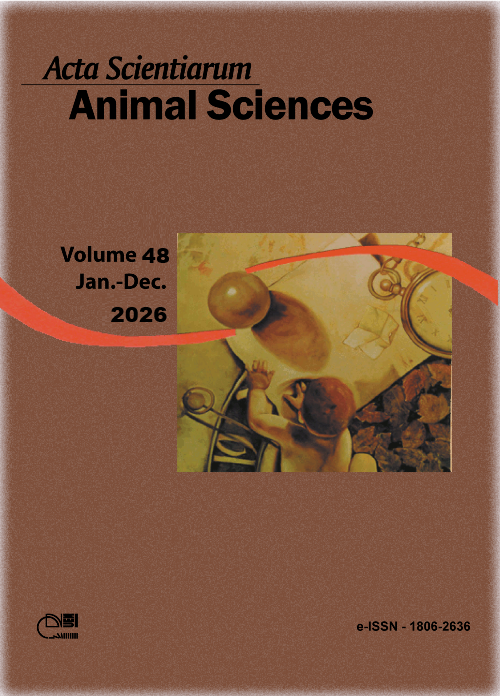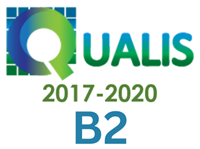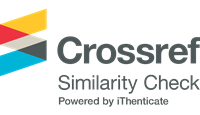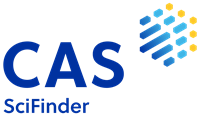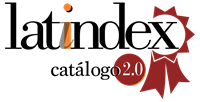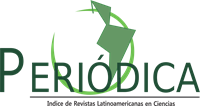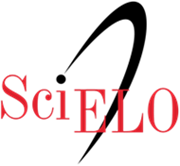Sperm quality of drones of Apis mellifera L. selected for royal jelly production
Resumo
Royal jelly is importance within the hive colony for feed and regulation of sex hormones. The objective of this study was to evaluate the reproductive characteristics of drones with D and E alleles (high production of royal jelly), compared with at least one F or G alleles (lower production of royal jelly). Drones were created from selected colonies and an analysis of the semen quality and weight of each drone was performed. The colonies with alleles D and E had a higher drone production but with lower. However, there was no interference from the alleles on the sperm quality of the drone, which presented: survival 88.38%, volume 1.2 µL, mass motility 5. The abnormalities were bent tail, headless and tailless sperm, and bifurcated tail. The alleles D and E influenced the weight and quantity of the drones but not their sperm quality.
Downloads
Referências
Abdelkader, F. B., Kairo, G., Tchamitchian, S., Cousin, M., Senechal, J., Crauser, D., ... Brunet, J. L. (2014). Semen quality of honey bee drones maintained from emergence to sexual maturity under laboratory, semi-field and field conditions. Apidologie, 45, 215–223. doi: 10.1007/s13592-013-0240-7.
Acassio dos Reis, V. D., & ComAbdelkader, F. B., Kairo, G., Tchamitchian, S., Cousin, M., Senechal, J., Crauser, D., Vermandere, J. P., Alaux, C., Le Conte, Y., Belzunces, L. P., Barbouche, N., & Brunet, J. L. (2014). Semen quality of honey bee drones maintained from emergence to sexual maturity under laboratory, semi-field and field conditions. Apidologie, 45, 215-223. https://doi.org/10.1007/s13592-013-0240-7
Albert, Š., Klaudiny, J., & Šimúth, J. (1999). Molecular characterization of MRJP3, highly polymorphic protein of honeybee (Apis mellifera) royal jelly. Insect biochemistry and insect molecular biology, 29, 427–434.
Baitala, T. V., Faquinello, P., Toledo, V. D. A. A., Mangolin, C. A. Martins, E. N., & Ruvolo-Takasusuki, M. C. C. (2010). Potential use of major royal jelly proteins (MRJPs) as molecular markers for royal jelly production in Africanized honeybee colonies. Apidologie, 41, 160-168. https://doi.org/10.1051/apido/2009069
Bieńkowska, M., Panasiuk, B., Wegrzynowicz, P., & Gerula, D. (2011). The effect of different thermal conditions on drone semen quality and number of spermatozoa entering the spermatheca of queen bee. Journal of Apicultural Science, 55, 161-168.
Blom, E. (1950). A one-minute live-dead sperm stain by means of eosin-nigrosin. Fertility and Sterility, 1, 176-177.
Boes, K. E. (2010). Honeybee colony drone production and maintenance in accordance with environmental factors: an interplay of queen and worker decisions. Insectes Sociaux, 57(1), 1-9. https://doi.org/10.1007/s00040-009-0046-9
Bratu, I. C., Igna, V., Simiz, E., Dunea, I. B., & Pătruică S. (2022). The Influence of body weight on semen parameters in Apis mellifera drones. Insects, 13(12), 1141. https://doi.org/10.3390/insects13121141
Brito, L. F. C., Barth, A. D., Bilodeau-Goeseels, S., Panich, P. L., & Kastelic, J. P. (2003). Comparison of methods to evaluate the plasmalemma of bovine sperm and their relationship with in vitro fertilization rate. Theriogenology, 60(8), 1539-1551. https://doi.org/10.1016/s0093-691x(03)00174-2
Neves, J. P., & Jobim, M. I. M. (2013a). Introdução ao exame andrológico. In J. P. Neves, & M. I. M. Jobim (Orgs.), Manual para exame andrológico e avaliação do sêmen animal (pp. 20-25). CBRA.
Neves, J. P., & Jobim, M. I. M. (2013b). Anexos. In J. P. Neves, & M. I. M. Jobim (Orgs.), Manual para exame andrológico e avaliação do sêmen animal (pp. 85-90). CBRA.
Cobey, S. W., Tarpy, D. R., & Woyke, J. (2013). Standard methods for instrumental insemination of Apis mellifera queens. Journal of Apicultural Research, 52(4 part 2), 1-18. https://doi.org/10.3896/IBRA.1.52.4.09
Cruz-Landim, C., Beig, D., & Moraes, R. L. M. S. (1980). The process of differentiation during spermatogenesis in bees (Hymenoptera, apidae). Caryologia, 33(1), 1-15. http://dx.doi.org/10.1080/00087114.1980.10796814
Czekońska, K., Chuda-Mickiewicz, B., & Chorbiński, P. (2013). The influence of honey bee (Apis mellifera) drone age on volume of semen and viability of spermatozoa. Journal of Apicultural Sciences, 57(1), 61-65. https://doi.org/10.2478/jas-2013-0007
Czekońska, K., Chuda-Mickiewicz, B., & Samborski, J. (2015). Quality of honeybee drones reared in colonies with limited and unlimited access to pollen. Apidologie, 46, 1–9.
Frost, E. (2016a). Breeding stock evaluation and maintenance. In E. Frost, Queen bee breeding (pp. 55-74). NSW Government.
Frost, E. (2016b). Selective breeding programs. In E. Frost, Queen bee breeding (pp. 79-84). NSW Government.
Gençer, V. H., & Kahya, Y. (2011). Are sperm traits of drones (Apis mellifera L.) from laying worker colonies noteworthy? Journal of Apicultural Research, 50(2), 130-137. https://doi.org/10.3896/IBRA.1.50.2.04
Gençer, H. V., Kahya, Y., & Woyke, J. (2014). Why the viability of spermatozoa diminishes in the honeybee (Apis mellifera) within short time during natural mating and preparation for instrumental insemination. Apidologie, 45, 757-770. https://doi.org/10.1007/s13592-014-0295-0
Halak, A. L., Santos, P. R., Rossi, R. M., Wielewski, P., Moraes, G.V., & Toledo, V. A. A. (2020). Drone production, semen viability and spermatozoa longevity of Africanized Apis mellifera. Acta Scientiarum. Animal Sciences, 42(1), e49050. https://doi.org/10.4025/actascianimsci.v42i1.49050
Han, H., Gebreamlak, B., Mao, F., Qiaohong, W., Xufeng, Z., Wu, F., Meng, L., Fang, Y., Han, B. e J. L. (2019). In-depth proteome of the hypopharyngeal glands of honeybee workers reveals highly activated protein and energy metabolism in priming the secretion of royal jelly. Molecular & Cellular Proteomics, 18, 606–621.
Herman, H. A., & Madden, F. W. (1994). Evaluation of semen-live-dead (Vital)stainig. In H. A. Herman, & J. R. Mitchell, Artificial insemination and embryo transfer dairy beef cattle (pp. 81-83). Interstate Printers & Publishers.
Jourdan-Pineau, H., Antoine, G., Galataud, J., Delatte, H., Simiand, C., & Clémencet, J. (2021). Estimating heritability in honeybees: comparison of three major methods based on empirical and simulated datasets. Ecology and Evolution, 11(13), 8475-8486 https://doi.org/10.1002/ece3.7389
Helbing, S., Lattorff, H. M. G., Moritz, R. F. A., & Buttstedt, A. (2017). Comparative analyses of the major royal jelly protein gene cluster in three Apis species with long amplicon sequencing. DNA Research, 24(3), 279-287. https://doi.org/10.1093/dnares/dsw064
Kleinbaum, D. G., & Klein, M. (2002). Logistic regression. Springer-Verlag.
Koeniger, G., Koeniger, N., Ellis, J., & Connor, L. (2014a). Drone monogamy, queen polyandry and the function of the mating sign. In G. Koeniger, N. Koeniger, J. Ellis, & L. Connor, Mating biology of honeybees (Apis mellifera) (pp. 87-96). Wicwas Press LLC.
Koeniger, G., Koeniger, N., Ellis, J., & Connor, L. (2014b). Drone quality influences the fecundity of queens. In G. Koeniger, N. Koeniger, J. Ellis, & L. Connor, Mating biology of honeybees (Apis mellifera) (pp. 116-123). Wicwas Press LLC.
Koeniger, G., Koeniger, N., Ellis, J., & Connor, L. (2014c). Relationships within the honeybee colony. In G. Koeniger, N. Koeniger, J. Ellis, & L. Connor, Mating biology of honeybees (Apis mellifera) (pp. 130-135). Wicwas Press LLC.
Mandla, R., & Kumar, N. R. (2016). Comparison of carbohydrates in the worker, drone and queen brood food of Apis mellifera during spring. Journal of Global Bioscience, 5(3), 3765-3768.
Metz, B. N., & Tarpy, D. R. (2019). Reproductive senescence in drones of the honey bee (Apis mellifera). Insects, 10(1), 11. https://doi.org/10.3390/insects10010011
Montgomery, D. C. (2017). Design and analysis of experiments. Jhon Wiley & Sons.
Oberlender, G., Murgas, L. D. S., Zangeronimo, M. G., Silva, A. C., Pereira, L. J., & Muzzi, R. A. L. (2012). Comparison of two different methods for evaluating boar semen morphology. Archivos de Medicina Veterinaria, 205, 201-205.
Ostroverkhova, N. V., Kucher, A. N., Babushkina, N. P., & Konusova, O. L. (2018a). Sequence of the mrjp3 microsatellite locus in honeybees of different origin. Russian Journal of Genetics, 54, 322–327.
Ostroverkhova, N. V, A. N. Kucher, O. L. Konusova, & I. V Sharakhov. 2018b. Honeybee subspecies or / and royal jelly productivity. Far Eastern Entomologist. 353, 24-28.
Parpinelli, R. S., Ruvolo-Takasusuki, M. C. C., & Toledo, V. A. A. (2014). MRJP microsatellite markers in Africanized Apis mellifera colonies selected on the basis of royal jelly production. Genetics and Molecular Research, 13, 6724–6733.
Paula, G. A. (2004). Modelos de regressão: com apoio computacional. IME-USP.
Pintado, B., De La Fuente, J., & Roldan, E. R. S. (2000). Permeability of boar and bull spermatozoa to the nucleic acid stains propidium iodide or Hoechst 33258, or to eosin: Accuracy in the assessment of cell viability. Journal of Reproduction and Fertility, 118(1), 145-152.
Polkovnikova, V. I., & Pershina, N. S. (2017). Efficiency of instrumental insemination use of bee queens. Agriculture, 4(58), 160-163.
Qu, N., Jiang, J., Sun, L., Lai, C., Sun, L., & Wu, X. (2008). Proteomic characterization of royal jelly proteins in Chinese (Apis cerana cerana) and European (Apis mellifera) honeybees. Biochemical, 73, 676–680.
R Development Core Team. (2014) R: a language and environment for statistical computing. R Foundation for Statistical Computing.
Rortais, A., Arnold, G., Halm, M. P., & Touffet-Briens, F. (2005). Modes of honeybees exposure to systemic insecticides: estimated amounts of contaminated pollen and nectar consumed by different categories of bees. Apidologie, 36(1), 71-83. https://doi.org/10.1051/apido:2004071
Rousseau, A., Fournier, V., & Giovenazzo, P. (2015). Apis mellifera (Hymenoptera: Apidae) drone sperm quality in relation to age, genetic line, and time of breeding. Canadian Entomologist, 147(6), 702-711. https://doi.org/10.4039/tce.2015.12
Rousseau, A., & Giovenazzo, P. (2016). Optimizing drone fertility with spring nutritional supplements to honey bee (Hymenoptera: Apidae) colonies. Journal of Economy Entomology, 109(3), 1009-1014. https://doi.org/10.1093/jee/tow056
Swanson, E. W., & Bearden, H. J. (1951). An Eosin-Nigrosin stain for differentiatinglLive and dead bovine spermatozoa. Journal of Animal Science, 10(4), 981-987. https://doi.org/10.2527/jas1951.104981x
Szentgyörgyi, H., Czekońska, K., & Tofilski, A. (2017). The effects of starvation of honey bee larvae on reproductive quality and wing asymmetry of honey bee drones. Journal of Apicultural Science, 61(2), 233-243. https://doi.org/10.1515/JAS-2017-0018
Taylor, M. A., Guzmán-Novoa, E., Morfin, N., & Buhr, M. M. (2009). Improving viability of cryopreserved honey bee (Apis mellifera L.) sperm with selected diluents, cryoprotectants, and semen dilution ratios. Theriogenology, 72(2), 149-159. https://doi.org/10.1016/j.theriogenology.2009.02.012
Valczircel, M. A., De las Heras, L., Perez, D. F. M., & Baldassarre, H. (1994). Fluorescent staining as a method of assessing membrane damage and post-thaw survival of ram spermatozoa. Theriogenology, 41(2), 483-488. https://doi.org/10.1016/0093-691x(94)90084-v
Wegener, J., May, T., Knollmann, U., Kamp, G., Müller, K., & Bienefeld, K. (2012) In vivo validation of in vitro quality tests for cryopreserved honeybee semen. Cryobiology, 65(2), 126-131. https://doi.org/10.1016/j.cryobiol.2012.04.010
Widdicombe, J. (2015a). The theory of bee improvement. In J. Widdicombe, The principles of bee improvement (pp. 5-22). Northern Bee Books.
Widdicombe, J. (2015b). Assessment of stock (ii) selecting within a strain. In J. Widdicombe, The principles of bee improvement (pp. 23-29). Northern Bee Books.
Widdicombe, J. (2015c). Queen mating- the role and importance of the drone. In J. Widdicombe, The principles of bee improvement (pp. 62-66). Northern Bee Books.
Williams, W. W., & Pollak, O. J. (1950). Study of sperm vitality with the aid of Eosin-Nigrosin stain. Fertility and Sterility, 1, 178-181.
Yániz, J., Palacin, I., & Santolaria, P. (2019). Efeito das características da câmara, incubação e diluente na motilidade do esperma do zangão da abelha (Apis mellifera). Apidologie, 50, 472-481. 10.1007/s13592-019-00659-y
Yániz, J. L., Silvestre, M. A., & Santolaria, P. (2020). Sperm quality assessment in honey bee drones. Biology, 9(7), 174. https://doi.org/10.3390/biology9070174
astri Filho, J. (2003) Importância da apicultura no pantanal sul-mato-grossense. https://ainfo.cnptia.embrapa.br/digital/bitstream/item/81133/1/DOC56.pdf).
Baitala, T. V., Faquinello, P., De Toledo, V. D. A. A., Mangolin, C. A. Martins, E. N., & Ruvolo-Takasusuki, M. C. C. (2010) Potential use of major royal jelly proteins (MRJPs) as molecular markers for royal jelly production in Africanized honeybee colonies. Apidologie, 41, 160–168.
Bieńkowska, M., Panasiuk, B., Wegrzynowicz, P., & Gerula, D. (2011) The effect of different thermal conditions on drone semen quality and number of spermatozoa entering the spermatheca of queen bee. Journal of Apicultural Science, 55, 161–168.
Blom, E. (1950) A One-Minute Live-Dead Sperm Stain by Means of Eosin-Nigrosin. Fertility and Sterility, 1, 176–177.
Boes, K. E. (2010) Honeybee colony drone production and maintenance in accordance with environmental factors: An interplay of queen and worker decisions. Insectes Sociaux, 57, 1–9.
Bratu, I.C., Igna, V., Simiz, E., Dunea, I. B., & Pătruică S. (2022). The Influence of Body Weight on Semen Parameters in Apis mellifera Drones. Insects, 13(12), 1141. doi: 10.3390/insects13121141.
Brito, L. F. C., Barth, A. D., Bilodeau-Goeseels, S., Panich, P. L., & Kastelic, J. P. (2003) Comparison of methods to evaluate the plasmalemma of bovine sperm and their relationship with in vitro fertilization rate. Theriogenology, 60, 1539–1551.
CBRA. (2013) Manual para exame andrológico e avaliação do sêmen animal, Colégio Brasileiro de Reprodução animal (org.)3 Ed. Belo Horizonte. p. 20–25, 85 e 90.
Cobey, S. W. (2007) Comparison studies of instrumentally inseminated and naturally mated honey bee queens and factors affecting their performance. Apidologie, 38, 390–410.
Cobey, S. W., Tarpy, D. R., & Woyke, J. (2013) Standard methods for instrumental insemination of Apis mellifera queens. Journal of Apicultural Research, 52.
Cruz-Landim, C., Beig, D., & De Moraes, R. L. M. S. (1980) The process of differentiation during spermatogenesis in bees (Hymenoptera, apidae). Caryologia, 33, 1–15.
Czekońska, K., Chuda-Mickiewicz, B., & Chorbiński, P. (2013) The influence of honey bee (Apis mellifera) drone age on volume of semen and viability of spermatozoa. Journal of Apicultural Sciences, 57, 61–65.
Frost, E. (2016a). Breeding stock evaluation and maintenance, in: _____ Queen bee breeding. NSW Government, Paterson, pp. 55-74.
Frost, E. (2016b). Selective breeding programs, in: _____ Queen bee breeding. NSW Government, Paterson, pp. 79-84.
Gençer, V. H., & Kahya, Y. (2011) Are sperm traits of drones (Apis mellifera L.) from laying worker colonies noteworthy? Journal of Apicultural Research, 50, 130–137.
Gençer, H. V., Kahya, Y., & Woyke, J. (2014) Why the viability of spermatozoa diminishes in the honeybee (Apis mellifera) within short time during natural mating and preparation for instrumental insemination. Apidologie, 45, 757–770.
Halak, A. L., Santos, P. R., Rossi, R. M., Wielewski, P., De Moraes, G.V., & De Toledo, V. A. A. (2020) Drone production, semen viability and spermatozoa longevity of Africanized Apis mellifera. Acta Scientiarum. Animal Sciences,15, e49050.
Harry, A. H., & Madden, F. W. (1993) Evaluation of semen-live-dead (Vital)stainig, In Interstate publishers (org.), Artificial Insemination and embryo Transfer dairy beef cattle. Danville. p. 81–83.
Haydak, M. (1970) Honey Bee Nutrition1. Annual Review of Entomology, 15, 143-156.
Jourdan-Pineau, H., Antoine, G., Galataud, J., Delatte, H., Simiand, C., & Clémencet, J. (2021). Estimating heritability in honeybees: Comparison of three major methods based on empirical and simulated datasets. Ecology and Evolution, DOI:10.1002/ece3.7389
Helbing, S., Lattorff, H. M. G., Moritz, R. F. A., & Buttstedt, A. (2017). Comparative analyses of the major royal jelly protein gene cluster in three Apis species with long amplicon sequencing. DNA Research, 24 (3), 279–287, https://doi.org/10.1093/dnares/dsw064
Kleinbaum, D. G., & Klein, M. (2002) Logistic regression. In Springer-Verlag New York. p. 701.
Koeniger, G., Koeniger, N., Ellis, J., & Connor, L. (2014a). Drone monogamy, queen polyandry and the function of the mating sign, in: _____ Mating biology of honeybees (Apis mellifera). Wicwas Press LLC, Michigan, pp. 87-96.
Koeniger, G., Koeniger, N., Ellis, J., & Connor, L. (2014b). Drone quality influences the fecundity of queens, in: _____ Mating biology of honeybees (Apis mellifera). Wicwas Press LLC, Michigan, pp. 116-123.
Koeniger, G., Koeniger, N., Ellis, J., & Connor, L. (2014c). Relationships within the honeybee colony, in: _____ Mating biology of honeybees (Apis mellifera). Wicwas Press LLC, Michigan, pp. 130-135.
Mandla, R., & Kumar, N. R. (2016) Comparison of carbohydrates in the worker, drone and queen brood food of Apis mellifera during spring. Journal of Global Bioscience, 5, 3765–3768.
Matsuka, M., Watabe, N., & Takeuchi, K. (1973) Analysis of the food of larval drone honeybees. Journal of Apicultural Research, 12, 3–7.
Metz, B. N., Tarpy, D. R. (2019) Reproductive senescence in drones of the honey bee (Apis mellifera). Insects, 10. Pii,E11.
Montgomery, D. C. (2017) Design and analysis of experiments. In: Jhon wiley & sons, Hoboken. p. 717.
Oberlender, G., Murgas, L. D. S., Zangeronimo, M. G., Silva, A. C., Pereira, L. J., & Muzzi, R. A. L. (2012) Comparison of two different methods for evaluating boar semen morphology. Archivos de Medicina Veterinaria, 205, 201–205.
Paula, G. A. (2004) Modelos de regressão: com apoio computacional. In: IME-USP, São Paulo. p. 428.
Pintado, B., De La Fuente, J., & Roldan, E. R. S. (2000) Permeability of boar and bull spermatozoa to the nucleic acid stains propidium iodide or Hoechst 33258, or to eosin: Accuracy in the assessment of cell viability. Journal of Reproduction and Fertility, 118, 145–152.
Polkovnikova, V. I., & Pershina, N. S. (2017) Efficiency of instrumental insemination use of bee queens. Agriculture, 4(58), 160-163.
R development Core Team. (2014) R: a language and environment for statistical computing. R Foundation for Statistical Computing. Vienna.
Rortais, A., Arnold, G., Halm, M.P., & Touffet-Briens, F. (2005) Modes of honeybees exposure to systemic insecticides: estimated amounts of contaminated pollen and nectar consumed by different categories of bees. Apidologie, 36, 71–83.
Rousseau, A., Fournier, V., & Giovenazzo, P. (2015) Apis mellifera (Hymenoptera: Apidae) drone sperm quality in relation to age, genetic line, and time of breeding. Canadian Entomologist. 147, 702–711.
Rousseau, A., & Giovenazzo, P. (2016) Optimizing drone fertility with spring nutritional supplements to honey bee (Hymenoptera: Apidae) colonies. Journal of Economy Entomology, 109, 1009–1014.
Swanson, E. W., & Bearden, H. J. (1951) An Eosin-Nigrosin stain for differentiatinglLive and dead bovine spermatozoa. Journal of Animal Science, 10, 981–987.
Szentgyörgyi, H., Czekońska, K., & Tofilski, A. (2017) The effects of starvation of honey bee larvae on reproductive quality and wing asymmetry of honey bee drones. Journal of Apicultural Science, 61, 233–243.
Taylor, M. A., Guzmán-Novoa, E., Morfin, N., & Buhr, M. M. (2009) Improving viability of cryopreserved honey bee (Apis mellifera L.) sperm with selected diluents, cryoprotectants, and semen dilution ratios. Theriogenology, 72, 149–159.
Valczircel, M. A., De las Heras, L., Perez, D. F. M., & Baldassarre, H. (1994) Fluorescent staining as a method of assessing membrane damage and post-thaw survival of ram spermatozoa. Theriogenology, 41, 483–488.
Wegener, J., May, T., Knollmann, U., Kamp, G., Müller, K., & Bienefeld, K. (2012) In vivo validation of in vitro quality tests for cryopreserved honeybee semen. Cryobiology, 65, 126–131.
Widdicombe, J. (2015a). The theory of bee improvement, in: ______ The principles of bee improvement. North. Bee Books, Mytholmroyd, pp. 5-22.
Widdicombe, J. (2015b). Assessment of stock (ii) selecting within a strain, in: ______ The principles of bee improvement. North. Bee Books, Mytholmroyd, pp. 23-29.
Widdicombe, J. (2015c). Queen mating- the role and importance of the drone, in: ______ The principles of bee improvement. North. Bee Books, Mytholmroyd, pp. 62-66.
Williams, W. W., & Pollak, O. J. (1950) Study of sperm vitality with the aid of Eosin-Nigrosin stain. Fertility and Sterility, 1, 178–181.
Woyke, J. (2011) The mating sign of queen bees originates from two drones and the process of multiple mating in honeybees. Journal of Apicultural Research, 50, 272–283.
Yaniz, J., Palacin, I., & Santolaria, P. (2019). Efeito das características da câmara, incubação e diluente na motilidade do esperma do zangão da abelha (Apis mellifera). Apidologie, 50, 472–481. doi: 10.1007/s13592-019-00659-y.
Yániz, J.L., Silvestre, M. A., & Santolaria, P. (2020) Sperm Quality Assessment in Honey Bee Drones. Biology, 9, 174.
Copyright (c) 2026 Sandra Milena Diaz Puentes, José Washington Santos Oliveira, Breno Gabriel da Silva, Yana Miranda Borges, Gentil de Moraes Vanini, Maria Claudia Colla Ruvolo-Takasusuki, Claudete Aparecida Mangolin, Vagner de Alencar Arnaut de Toledo

This work is licensed under a Creative Commons Attribution 4.0 International License.
DECLARAÇÃO DE ORIGINALIDADE E DIREITOS AUTORAIS
Declaro que o presente artigo é original, não tendo sido submetido à publicação em qualquer outro periódico nacional ou internacional, quer seja em parte ou em sua totalidade.
Os direitos autorais pertencem exclusivamente aos autores. Os direitos de licenciamento utilizados pelo periódico é a licença Creative Commons Attribution 4.0 (CC BY 4.0): são permitidos o compartilhamento (cópia e distribuição do material em qualqer meio ou formato) e adaptação (remix, transformação e criação de material a partir do conteúdo assim licenciado para quaisquer fins, inclusive comerciais.
Recomenda-se a leitura desse link para maiores informações sobre o tema: fornecimento de créditos e referências de forma correta, entre outros detalhes cruciais para uso adequado do material licenciado.
Funding data
-
Coordenação de Aperfeiçoamento de Pessoal de Nível Superior
Grant numbers 88882.181502/2018-01




